« July 2008 | Main | December 2008 »
August 29, 2008
Mary's Place
Some dives are adrenalin-pumpers whereas others are relaxing. At the end of the Roatan trip I was at a place where I was able to relax. I knew that my equipment worked fine and my body, too, and that I would not suddenly freak underwater. I also found myself increasingly able to release all tension and hover, simply let go and enjoy the total lack of gravity. I became much better with buoyancy and had to add and drop air to my BC less and less often. I worked on the bad habit of using my left arm and hand to help manoeuver instead of using fins. With one's breathing under control and a total sense of relaxation, diving assumes a dreamlike quality that is quite addictive. Floating weightlessly becomes natural and seems the norm. I concentrated on finning and gliding with slow, fluid and deliberate movements. That not only conserves air and energy, but also keeps you from harming sea fans, sponges, and other plants.
Between the much better buoancy in seawater and my increasing diving experience, I managed to stay clear of plant life and didn't kick up silt or sand. I only layed on the bottom a couple of times, on purpose, and virtually never used my hands to push off. CoCo View does not allow the wearing of gloves, and so the temptation to touch was greatly diminished. I don't think I touched anything on purpose more than once or twice. Some plants and critters sting or burn, and so it's better to stay clear anyway.
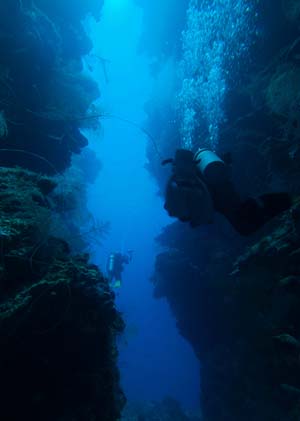 Mary's Place is one of Roatan's most famous dive sites. It is a horseshoe-shaped fragment that broke off from the main reef, perhaps during an earthquake long ago. When that happened, a number of deep cracks and crevices formed and you can now dive through those. The cracks are narrow enough to mandate swimming through them single file and make for wonderfully dramatic scenery. At a moderate pace it takes maybe six to ten minutes to swim through the main crevice of the formation. Attendance at a special buoyancy control seminar is usually required before diving Mary's Place and the site is listed as suitable for intermediate level divers on up.
Mary's Place is one of Roatan's most famous dive sites. It is a horseshoe-shaped fragment that broke off from the main reef, perhaps during an earthquake long ago. When that happened, a number of deep cracks and crevices formed and you can now dive through those. The cracks are narrow enough to mandate swimming through them single file and make for wonderfully dramatic scenery. At a moderate pace it takes maybe six to ten minutes to swim through the main crevice of the formation. Attendance at a special buoyancy control seminar is usually required before diving Mary's Place and the site is listed as suitable for intermediate level divers on up.
The initial drop-off was at just 25 feet or so on top of the reef plateau. We then dropped over the wall and descended to about 75 feet. I was a bit nervous as I always am with new adventures as we came upon the entrance of the main crack along the wall. It was adorned by beautiful black coral whose branches actually look orange. On divemaster Eddie's go-ahead we went in one by one. I was videotaping the entire swim-through on the SeaLife DC800 camera. Carol was right behind me with the big Olympus digital SLR. The flat, sandy bottom of the cracks was at perhaps 90 feet or so, though I never went deeper than 75 or 80. I enjoyed this dive very much. Mary's Place lived up to expectation, and then some.
The magical traverse between the otherwordly cliffs was over all too soon. At the end there are two exits, one going straight ahead and expelling the diver into the wide, blue ocean with the wall dropping away to the left and right. Divemaster Eddie suggested we take the last left turn that ascended to another exit, one that was wonderfully picturesque and led back to another exit at maybe 60 feet. When I got to the junction I wasn't quite sure which way to turn as the left turn is just feet before the main crack opens into the ocean. It is fairly narrow and goes uphill. I took that one, working my way up to the exit where we all lingered and took in the sights.
What I didn't know at the time was that Mary's Place, on Valentine's Day of 1990, was the site of an open water deep diving record. Bret Gilliam chose Mary's Place because of the near vertical wall with "abyssal drop-off depths." On a single 100 cubic-foot tank of compressed air, Gilliam reached a depth of 452 feet, performed a few math and word problems on a slate to test his alertness at that depth, and began his ascent after six minutes and 20 seconds. He did hist first deco stop at 50 feet, and an hour and 16 minute slater he surfaces none the worse for wear, having answered all the test problems on his slate correctly.
This was, incidentally, my 50th dive and I couldn't have wished for a nicer experience. Or for a better conclusion to a truly memorable week of diving at CoCo View resort on Roatan.
Posted by conradb212 at 12:53 AM
August 27, 2008
Waves, surge, sharks and night dives
Lakes are rarely rough and so my diving before Roatan had been in calm water, all of it. I really did not know what to expect from the sea. I remember long vacations on the beaches of Italy and Western France and how the surf pounded the beach, sometimes so strongly that a flag was up indicating that there would be no swimming that day. The beaches on the Outer Banks of North Carolina, of New England and the West Coast of the United States can all be rough and forbidding. On the other hand, I've seen gentle beaches with crystal-clear water and white sand on Spain's Costa Del Sol in the late 1970s, and I still wish I could have been diving there.
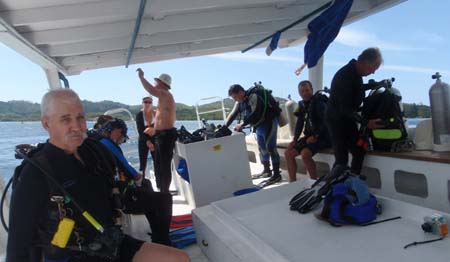
Diving in the sea is different. I learned that it can be as calm underwater as in a lake or spring. And even if there are some waves on the surface, once you go under it's all still. But that's not always the case. On some of the dives the water was pretty rough down there. What is waves on the surface is surge at the bottom. You get buffeted around in a rhythm and it becomes more difficult to move and control where you're going. That can be a problem when you want to get close to something so you can take pictures but also want to make sure you don't bump into it and harm the plants. Several times I found myself entirely too close to a wall with its rich cover of sponges and all sorts of outlandish growth, and was unable to get away from it without the vigorous use of fins that might have harmed the plants. Sometimes surge is obvious as in when you see the plantlife swaying back and forth. Other times you don't see it, but feel that you're just not going where you think your movements should get you.
In addition, there's current. Here again, things can be deceptive. Sometimes it's very noticeable and you just fly away, other times you just marvel how effortlessly and quickly you can swim just to find that it isn't nearly as easy to go the other way. That can be a problem as you don't want to get separated from your buddy or buddies, and certainly not from the dive boat.
As for sharks, I didn't see any nor did I do the shark dive on my trip to Roatan. I felt I just wasn't quite ready as I was still acclimatizing myself to diving in the sea and learning something new with every dive. With the exception of a couple of barracudas and some groupers, all from a distance, I hadn't really seen any big fish, so starting out with a bunch of sharks in a feeding frenzy seemed a bit much. Some guests did go, though, and as I expected, they felt it was an incredible experience.
Brian, a very experienced diver from Tuscaloosa, Alabama, and his girlfriend Joanne, also an experienced diver, did go on the shark dive organized by a couple of Italian divemasters who run Waihuka Diving Adventures. The dive site they boat their daring customers to is called "Cara a Cara" -- Spanish for Face-to-Face. Brian said they went down along a line to about 70 feet where they stood and sat against a cliff. Shark feed operations use chum buckets full of stuff that sharks like and the local sharks know the routine. According to Brian, once the dinner bell is rung, the sharks, Caribbean Reef Sharks, appear in a hurry and do get into the feeding frenzy you see in TV documentaries. However, they have no interest whatsoever in the divers, just the food in the chum bucket. Divers are allowed to circle around the whole scene. Once the chum is gone, the sharks leave. The whole thing is recorded on video and participants can buy a DVD. I saw the DVD and it was stunning.
Maybe next time.
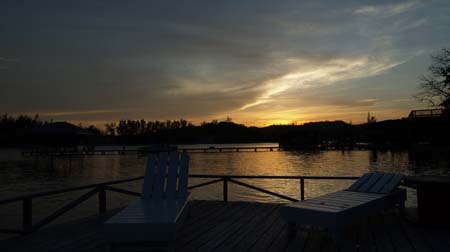
I did do one night dive. I had wanted to do more, but each day I was just too pooped after three or four dives to gear up yet again. Others went every night. For beach dives, the protocol at CoCo View is that a flashing strobe must be attached high above the bottom on the "front yard" buoy mooring chain. The first diver who goes out must take the strobe and attach it. Each subsequent diver then takes a numbered tag that must be clipped onto the chain. That way everyone knows divers are out there. Upon return, the last diver retrieves the strobe and brings it back in.
We went fairly late and everyone else, including the strobe, were already back. So we took it out again. We waded through the shallow part of the beach, then donned our fins and turned the divelights on. I brought two, my little Scubapro and a somewhat stronger backup. We quickly found an octopus and stopped to watch it. That was easier said than done for me as the lack of vision and visual references made hovering difficult. Carol attached the strobe to the mooring chain when we reached it and then we were off hunting for whatever might come out at night. There were, as I quickly noticed, a lot of curious fish, some of them quite large. It was mildly disconcerting to train my lights into the dark and then see shadows gliding in and out of my field of vision. Carol went off exploring with the Olympus Evolt 330 digital SLR and I stayed close, lighting things for her. We saw and photographed some interesting critters. The uneasiness never left me.
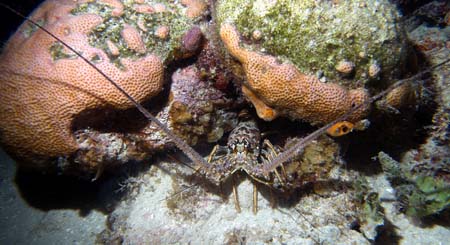
But it got worse. We encountered blood worms that swarm the divelights like angry flies. You'd think worms just wiggle around on the ground, but these pests buzzed around lights faster than anything I've ever encountered on land, and they got into things. Fortunately, I wore my 3mm wetsuit, but I still felt them against my hands, face and ears. I pulled my skullcap down over my ears as far as I could. Those things were an absolute pain and ruined whatever enjoyment I might have had out of that night dive. Yuk! We quickly retrieved the strobe and retreated to the beach. I'll try again to see if I can find the night dive magic many divers talk about.
Posted by conradb212 at 11:32 PM
August 26, 2008
Contemplations on a day off
There's much joking going on about "Montezuma's Revenge," the type of gastro-intestinal distress that can afflict travelers who are not used to Central American foods and microbiology. No one expects to become afflicted with it, but three days into the trip I woke up feeling not so well. I had been careful with eating and drinking but apparently not careful enough. 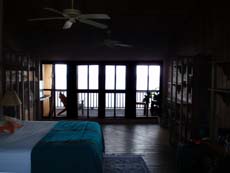 So it was diarrhea and feeling pretty awful. DAN, the Divers Alert Network, has guidelines on what and how to eat and drink in foreign countries, but I must admit I did not brush up on them before we left. I dragged myself to breakfast but did not manage to eat anything. It was obvious I was not up to diving and so I stayed in my room instead. I had seen a black beach towel laying in the water below the cabana that in the shadow looked just like a ray and so I wrote a children's story named "Ray, the ray" where the beach towel became real. I jotted down impressions about the trip. I dozed. I hoped I wouldn't be out of commission for the rest of the week. It'd be awful to have come all the way down to Honduras to experience ocean diving and then be sidelined by diarrhea.
So it was diarrhea and feeling pretty awful. DAN, the Divers Alert Network, has guidelines on what and how to eat and drink in foreign countries, but I must admit I did not brush up on them before we left. I dragged myself to breakfast but did not manage to eat anything. It was obvious I was not up to diving and so I stayed in my room instead. I had seen a black beach towel laying in the water below the cabana that in the shadow looked just like a ray and so I wrote a children's story named "Ray, the ray" where the beach towel became real. I jotted down impressions about the trip. I dozed. I hoped I wouldn't be out of commission for the rest of the week. It'd be awful to have come all the way down to Honduras to experience ocean diving and then be sidelined by diarrhea.
I took some Imodium tablets I'd brought along and wondered about the practical aspects of diving when you don't feel up to par. Boat rides can be pretty rough and sitting in a rocking boat on top of feeling nauseous to begin with didn't sound too good. And I wondered what would happen if you went diving and had to throw up. I'd read about that and apparently you're supposed to vomit through the regulator without taking it out of your mouth. I hoped I wouldn't have to put that to the test. As for diarrhea, the thought of suddenly having an uncontrollable urge while diving with a wetsuit on wasn't pretty.
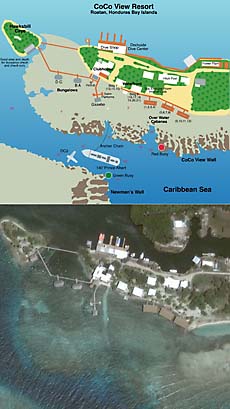 I thought about the amazing CoCo View resort and how it came about. I'd been to Central America in the late 1970s and visited El Salvador and Guatemala. Apparently, while I was lounging by the pool at the luxurious estate of my friends in San Salvador in 1978 and played tennis at the Salvador Sheraton, conditions on Roatan were still quite primitive. Roatan is part of the Honduran Bay Islands that also include Guanaja, Utila and a few dozen much smaller ones. The 49 square mile island was said to be discovered by Columbus on one of his later voyages, then visited by Spanish conquistador Velasquez in an episode disastrous for the indigenous Paya Indians who were enslaved and put to work. Roatan became popular with pirates who, together with the British, were a thorn in the side of the Spaniards. Spain essentially demolished the island by 1650 but English privateers returned and used Roatan as a base. Even the notorious pirate Blackbeard was there for a few weeks in 1718. In the 1700s it was a constant back and forth between England and Spain. By 1800, the English brought thousands of revolting slaves from other islands. Those were called the Garifuna and their descendants are still there today. Roatan was considered a British Crown Colony, albeit a rather minor and neglected one, and influential English families from the Cayman Islands arrived. Though the island was essentially English and Scotch, Queen Victoria, against protests from the settlers, turned Roatan over to an only vaguely interested Honduras in 1858. These days, the official language is Spanish, but many still speak English, and most municipalities have English names.
I thought about the amazing CoCo View resort and how it came about. I'd been to Central America in the late 1970s and visited El Salvador and Guatemala. Apparently, while I was lounging by the pool at the luxurious estate of my friends in San Salvador in 1978 and played tennis at the Salvador Sheraton, conditions on Roatan were still quite primitive. Roatan is part of the Honduran Bay Islands that also include Guanaja, Utila and a few dozen much smaller ones. The 49 square mile island was said to be discovered by Columbus on one of his later voyages, then visited by Spanish conquistador Velasquez in an episode disastrous for the indigenous Paya Indians who were enslaved and put to work. Roatan became popular with pirates who, together with the British, were a thorn in the side of the Spaniards. Spain essentially demolished the island by 1650 but English privateers returned and used Roatan as a base. Even the notorious pirate Blackbeard was there for a few weeks in 1718. In the 1700s it was a constant back and forth between England and Spain. By 1800, the English brought thousands of revolting slaves from other islands. Those were called the Garifuna and their descendants are still there today. Roatan was considered a British Crown Colony, albeit a rather minor and neglected one, and influential English families from the Cayman Islands arrived. Though the island was essentially English and Scotch, Queen Victoria, against protests from the settlers, turned Roatan over to an only vaguely interested Honduras in 1858. These days, the official language is Spanish, but many still speak English, and most municipalities have English names.
A 1996 report by a writer/diver/developer by the name of Lorenzo Dee Belveal who first came to Roatan in 1966, built Spyglass Hill Resort, and ran it until 1981 just when CoCo View got underway is interesting albeit perhaps controversial reading. A most prolific writer, Belveal described the primitive yet pristine condition of the island when he arrived, with spring-clear water and 200-foot visibility, and what he considers the subsequent overpopulation, loss of safe drinking water due to destruction of the natural aquifer and the resulting danger of water-borne disease. In 1995, Belveal's assessment was "It only took fifteen years for it to complete the circuit from "new and exciting" to "ruined and showing it," and his predictions for Roatan's future were dire.
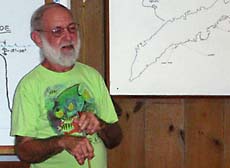 An account penned by Dennis Foster in circa 1990 describes the island as still quite primitive with barely a runway, not much in terms of roads (read Belveal's The Road for an idea), no telephone system and no reliable central electricity. Yet, by that time CoCo View resort had already existed for a decade, established by visionaries Bill and Evelyn Evans with the help of local and immigrated authorities. The "Prince Albert," for example, was named after Albert Jackson, a local tycoon and entrepreneur who built Fantasy Island across the lagoon from CoCo View in 1989 (view the Sinking of the Prince Albert). Another influential persona, "Doc" Radawski, is a fountain of historical knowledge and now resides at CoCo View. He came to Roatan in the early 1970s and has been playing a pivotal role in the scuba diving community as well as marine archeology and ecological programs geared towards preserving Roatan's natural beauty. I greatly enjoyed his excellent lecture on the history of Roatan.
An account penned by Dennis Foster in circa 1990 describes the island as still quite primitive with barely a runway, not much in terms of roads (read Belveal's The Road for an idea), no telephone system and no reliable central electricity. Yet, by that time CoCo View resort had already existed for a decade, established by visionaries Bill and Evelyn Evans with the help of local and immigrated authorities. The "Prince Albert," for example, was named after Albert Jackson, a local tycoon and entrepreneur who built Fantasy Island across the lagoon from CoCo View in 1989 (view the Sinking of the Prince Albert). Another influential persona, "Doc" Radawski, is a fountain of historical knowledge and now resides at CoCo View. He came to Roatan in the early 1970s and has been playing a pivotal role in the scuba diving community as well as marine archeology and ecological programs geared towards preserving Roatan's natural beauty. I greatly enjoyed his excellent lecture on the history of Roatan.
Fortunately and amazingly, in the afternoon I felt well enough to go diving. I found that I had missed some minor discord on the boat that occurred when a guest who was reviewing the resort for a publication or website requested four full boat dives a day as opposed to two dive site dives and two drop-offs. Drop-offs mean the boat won't take you back to the dock and you have to exit through the beach. At CoCo View that's a long swim in very shallow water, and no fun with extensive camera equipment. So the boat took him to some other dive site and thus was not at the dock when the drop-off divers arrived. Some had left personal belongings on the boat including, in one case, their room keys. That, admittedly, can be annoying and so there were complaints. Divemaster Eddie may have gotten an earful from management over that and was none too happy about it. So he called the group together and discussed the matter in a mature and straightforward manner. This young man will go far.
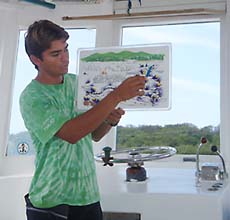 I later got to talk to Eddie whose blond-streaked hair, very much unlike mine, always looked perfectly towsled and coiffed minutes after a dive. His family came from mainland Honduras when he was three years old. They now own some real estate and a store. Eddie has been working in one capacity or another at CoCo View resort since he was in his early teens. He was a busboy, worked in the kitchen, the dive shop, etc., until he got a chance to get into diving. He started highschool, but still has to finish it. He took a course in English, and his mastery of the language is excellent. He fluently converses in English with an accent hardly thicker than mine. English, Eddie said, is necessary on the island to get a good job. That and computer knowledge. No one else in his family speaks English, and Eddie is trying to get at least his sister to learn it. He's never been to the United States but he has a dream of going to college and study something that relates to his love of diving and the sea. Marine biology perhaps. I hope he gets to realize that dream.
I later got to talk to Eddie whose blond-streaked hair, very much unlike mine, always looked perfectly towsled and coiffed minutes after a dive. His family came from mainland Honduras when he was three years old. They now own some real estate and a store. Eddie has been working in one capacity or another at CoCo View resort since he was in his early teens. He was a busboy, worked in the kitchen, the dive shop, etc., until he got a chance to get into diving. He started highschool, but still has to finish it. He took a course in English, and his mastery of the language is excellent. He fluently converses in English with an accent hardly thicker than mine. English, Eddie said, is necessary on the island to get a good job. That and computer knowledge. No one else in his family speaks English, and Eddie is trying to get at least his sister to learn it. He's never been to the United States but he has a dream of going to college and study something that relates to his love of diving and the sea. Marine biology perhaps. I hope he gets to realize that dream.
The dive site we visited was called Menagerhea, named or renamed after Rhea's Diving Services, the diveshop Carol managed for a number of years in Tennessee. The seas were a bit rough but I felt just fine, and even better once I was in the water. The site started out quite shallow, then we slowly descended down along a wall. Looking out into the open blue ocean we saw some pretty big fish, including barracudas and groupers. It's fascinating to gaze into the blueness and suddenly seeing a faint dark shadow that then becomes a fish. You can't quite tell how far away they are, or how big. The Menagerhea site is close to shore by the Newman Wall, and so there was quite a bit of surge.
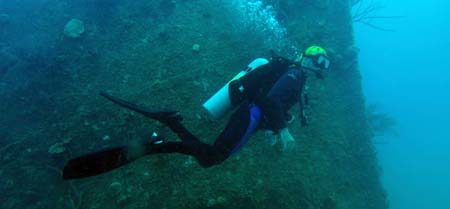
For the drop-off dive I chose the Prince Albert, but this time with a special mission. I took along the Olympus Stylus 1030SW, a 10-megapixel camera that's waterproof to 33 feet without an underwater housing. It's the successor to the Stylus 770SW that we'd taken down to 67 feet at Manatee Springs in Florida with no ill effect. For a while I thought that camera was invulnerable until it did flood at 90 feet in Lake Tahoe when I simply forgot that I'd taken it with me on the dive. I definitely did not want to kill the 1030 as well and so could only take it to the upper parts of the wreck. Still, that meant half an hour between 30 and 40 feet, and a bunch of pretty good pictures -- not bad for a camera that looks just like any other modern little digicam. The visibility wasn't the best, but it took decent pictures.
Posted by conradb212 at 12:06 AM
August 25, 2008
Prince Albert and green blood
In "Silent World," published in 1953, Captain Jacques-Yves Cousteau describes a new type of fish they had found in the French Mediterranean off Marseille. They'd gone deep and speared a good-sized liche and the fish bled. The blood, however, was emerald green and that was quite unusual. Ever the scientist, Cousteau made sure they'd get this trophy to the surface so they could examine the green-blooded fish. They did and were anxious to show their find to the team, but as they ascended the green blood turned brown, then pink. On the surface the fish was bleeding red like any other. Cousteau probably slapped his head and went, "Of course! You cannot see red deeper than 15 or 20 feet or so." When I read that I thought it was pretty strange. No more. I bleed green, too.
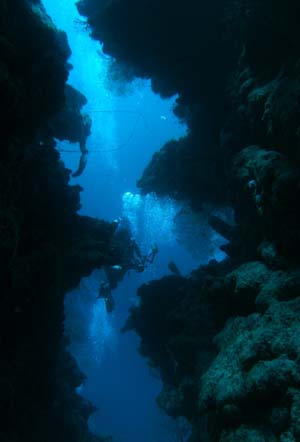 Whatever causes underwater nosebleeds struck me during a morning dive. The boat had taken us out to "Calvin's Crack," a gorgeous though somewhat oddly named dive site that's indeed a narrow crack in the reef (it was likely named after Calvin Bodden, friend of CoCo View founder Bill Evans). It descends all the way from a fairly shallow entrance area at maybe 30 feet of water to an opening to the ocean deep in the wall. The entrance is like a cave or cavern and you go in head-first, but it's not really an overhead environment as light remains visible through the top of the crack at all times.
Whatever causes underwater nosebleeds struck me during a morning dive. The boat had taken us out to "Calvin's Crack," a gorgeous though somewhat oddly named dive site that's indeed a narrow crack in the reef (it was likely named after Calvin Bodden, friend of CoCo View founder Bill Evans). It descends all the way from a fairly shallow entrance area at maybe 30 feet of water to an opening to the ocean deep in the wall. The entrance is like a cave or cavern and you go in head-first, but it's not really an overhead environment as light remains visible through the top of the crack at all times.
It is a wonderfully eery experience floating downward between walls of sheer rock to the left and right, from 30 feet to perhaps 80 or 90, with beams of light from the surface shining down from between the cliffs, and air bubbles from divers ahead of you rising in a silvery stream. Diving the crack is like floating through a rugged, narrow canyon with just enough room for a single diver. The sandy bottom of the crack descends until it opens on the side of the wall into the blue ocean at a depth of anywhere from 60 to 100 feet. I'd been nervous again before the dive, of course, but felt just fine going into and through the crack. It was all totally new to me and so I composed myself and finned through, not taking nearly enough time to look around and take it all in.
I exited Calvin's Crack at about 85 feet, with the bottom still well below me. It was over too soon, sort of like a rollercoaster ride at the carnival. The water felt noticeably colder once I emerged from the wall and was floating in the open ocean along the nearly vertical cliffs. Later, when I uploaded my dive computer data into my notebook I saw that the water temperature had dropped all of four degrees, from 86 to 82 degrees Fahrenheit. All thermoclines should be that mild.
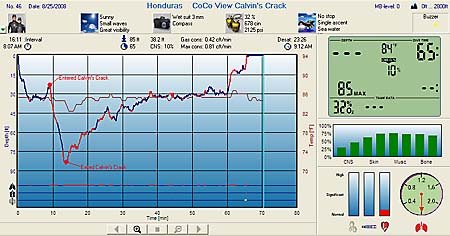
Over the next 25 minutes we slowly worked our way along the luscious wall and back up to shallower water. I noticed that the left side of my Scubapro Frameless mask was getting pretty murky with liquid accumulating at the bottom. There is almost always a little bit of water seeping into a mask and it's no big deal once you know how to purge. My Frameless mask is as leak-proof as I've experienced (I have tried out a dozen masks or so) and I rarely ever have to clear my mask to get the water out. I didn't like the murky greenish water and wasn't sure where it came from until it turned red as I ascended and then I knew. Nose or sinus bleed. Looks emerald green at depth. Nothing to be alarmed about, but definitely something I could do without. I cleared out the mask as much as I could before entering the dive boat through the cut-out with the ladder in the bottom, but Jorge, our boat captain, noticed right away and actually looked a bit alarmed. He gave me tissues once I was on the boat and I ended up needing quite a few of them. So that was a pretty good nosebleed.
I decided to skip the morning's "drop-off" dive and head back to the dock on the boat. That gave me a chance to roam around CoCo View resort a bit, look at the dozens of hummingbirds excitedly competing for a spot on one of the sugarwater bird feeders, and check out the well equipped PADI 5-Star dive shop (Dockside Dive Center). I asked the dive master and other authorities about the cause of the nosebleeds and what one can do about it, but no one seems to know for sure. I have no clue what causes regular nosebleeds (which I have rarely ever gotten), let alone ones caused by diving. They call seats high up in a stadium the "nosebleed section," so I suppose pressure has something to do with it. Carol said many divers, including accomplished ones, have to deal with this and that it usually goes away after a number of dives. I sure hoped it'd go away for me.
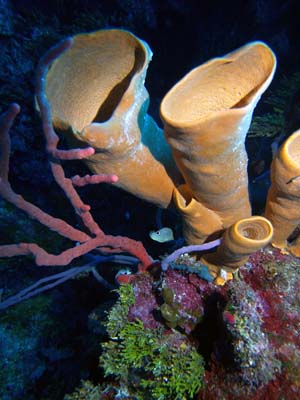 I did take the afternoon dive (Valley of the Kings), but made sure I stayed relatively shallow, never going deeper than 55 feet. The dive took us along a wall and then over an undulating reef plateau with lots to see. I think I'll never get tired of looking at the plants and sea creatures. I used to think real sponges looked like what my grand parents used in their bathroom. I had no idea they where tube-like structures in all forms, colors and sizes. Gliding through it all you never know what you'll see next. Many sea creatures have adapted themselves to a specific plant, mimicking shape, texture and color so they become nearly invisible against the backdrop of their host. Wonderful though it was, I felt a bit apprehensive after the green blood episode and so wasn't able to relax and enjoy as much as I should have. I did still have a bit of bleeding, but much less, and so I decided I was going to risk a second dive that afternoon. After surfacing and recuperating we asked the captain to take us to the wreck of the Prince Albert.
I did take the afternoon dive (Valley of the Kings), but made sure I stayed relatively shallow, never going deeper than 55 feet. The dive took us along a wall and then over an undulating reef plateau with lots to see. I think I'll never get tired of looking at the plants and sea creatures. I used to think real sponges looked like what my grand parents used in their bathroom. I had no idea they where tube-like structures in all forms, colors and sizes. Gliding through it all you never know what you'll see next. Many sea creatures have adapted themselves to a specific plant, mimicking shape, texture and color so they become nearly invisible against the backdrop of their host. Wonderful though it was, I felt a bit apprehensive after the green blood episode and so wasn't able to relax and enjoy as much as I should have. I did still have a bit of bleeding, but much less, and so I decided I was going to risk a second dive that afternoon. After surfacing and recuperating we asked the captain to take us to the wreck of the Prince Albert.
Not all wrecks are the same, and one sitting in 45 to 70 feet of water in a channel right outside of a dive resort is most definitely not in the same class as one much deeper somewhere in open water. But until I see one of them, if I ever will, as far as I am concerned, the Prince Albert is a real wreck and then some. It is a large iron vessel sitting upright. It was sunk almost 25 years ago specifically as a scuba attraction by the owners of the CoCo View resort. It has many openings to explore and has probably been proofed so it's safe for divers. Then again, it's still a wreck deep underwater and it can look very intimidating. The sheer mass of the wreck is humbling as you weightlessly glide along its coral and sponge-encrusted sides. The water whose clarity can be exceptional at the top of the wreck can dwindle to just a few feet at the sandy bottom. Plantlife has taken over and transformed the massive vessel of steel into a silent reef with dark gaping holes along the sides and on the top. It's all open for exploration without any supervision at all. I didn't have my divelight with me and so could not see what's inside. Not that I would have done so in the first place. Floating in darkness inside a rusted hull does not seem totally harmless. I must assume things are closed off enough so divers do not get lost, but it all did look forbidding and intimidating.
It is amazing how very quickly sealife takes over a sunken vessel. The seafans, sponges, and corrals of all kinds did not seem any different from those that grow on reefs and walls. I thought a wreck would be all mud and rust and sediment, but it's a living, teeming medley of plants and fish, and really quite indistinguishable from a reef. There are large, spindly plants that stick and fan out all over the place as well as the usual variety of sealife large and small. Fish and other critters are everywhere.
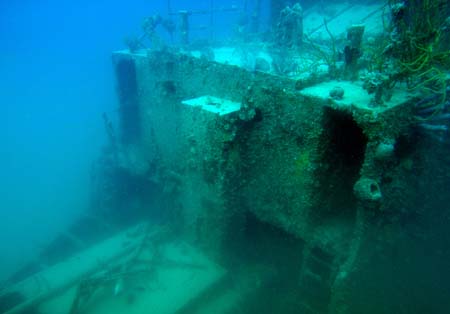
I thought of all the books I had read about divers exploring the Andrea Doria or the Empress of Ireland, and how those wrecks claim lives even from the very best. I don't think it's worth risking one's life for a porcellain plate from a sunken ship, but people know the level of risk they wish to take. Seeing the wreck of the Prince Albert gave me an idea of what it's all about. It was very real, very impressive, and a thrill.
Posted by conradb212 at 4:11 PM
August 24, 2008
First ocean dive
I've had my first ocean dive. It was actually three, an orientation dive in the morning and then two boat dives in the afternoon.
Apparently, no matter what age I am, I get uptight whenever I do something new for the first time. I fell asleep just fine the evening before the dive, and had a good night's sleep, but during breakfast and then the orientation upstairs in the clubhouse I was absurdly nervous. Just like I used to get when I had to give a speech.
We then got geared up and entered the very shallow water at the beach in front of CoCo View's clubhouse. Our divemaster, Melgar, gave an introduction: first we'd swim down an incline, then congregate at the anchor plate of the buoy to demonstrate skills (flooding and clearing the mask; removing the regulator and blowing bubbles), then go past the wreck of the Prince Albert and on to Newman's Wall, then back to the wreck and over to the other side where CoCo View Wall is. That sounded like an awful lot of distance for just an orientation dive, and it felt like it, too, but when it was all over it had taken all of 45 minutes.
I had often wondered what it'd be like to see a shipwreck underwater. I envisioned it as spooky and threatening, sort of the ultimate symbol of human maritime defeat. A ship sinks and goes down to the bottom of the ocean. The image of the water closing over it and it falling has always felt extremely ominous to me.
But seeing the Prince Albert, a 140 foot long hulking former tanker, was not that threatening. Maybe it was the good visibility, or maybe shipwrecks are just one of those things that looks and feels all different once you actually see one underwater. We did not stay and peruse the encrusted wreck of the ship that'd been sunk as a diving attraction in 1985. There'd be plenty of time for that later.
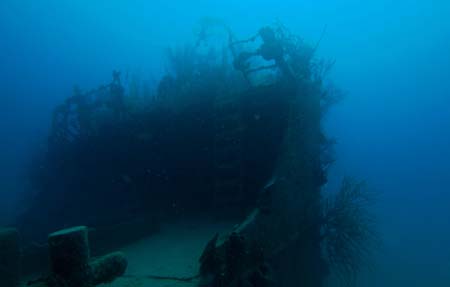
Close to the wreck we saw a school of squid slowly circling in formation. An amazing sight that was. They have those huge eyes and you never quite know which side is the front and which the back. They seem intelligent, very deliberate, and very different from fish that tend to dart around this way and that.
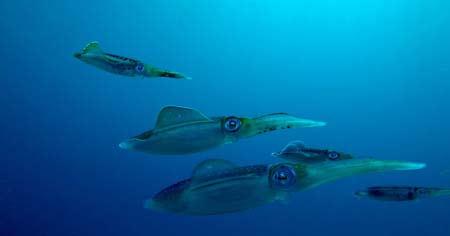
The Newman wall was imposing, and I assume representative for a lot of Caribbean underwater walls. It's far steeper and rockier down there than you'd expect judging by the looks of the geography above the water. Roatan is hilly, for sure, but it does not seem to have the sheer cliffs that drop down many hundreds or thousands of feet. And every square inch underwater is occupied by something -- plants, fish, sea critters of all kinds. This is really what blew me away most. Lake Tahoe has awesome scenery and walls, but it is nearly devoid of life. Here I saw nothing but life teeming all over the place.
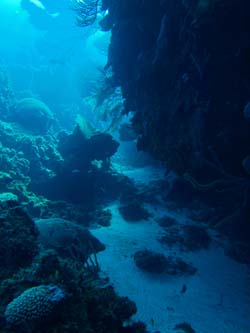 I still wrestled with some irrational fears, most of which I attribute to my initial uneasiness with new things. I am aware at all times, for example, of having all that water above me. If anything goes wrong there is simply no margin for error. What would happen if I had a sudden bout of ... something? Would I be able to handle it? Also, I do like to see what's around me, and I get uneasy when the visibility is bad and things go blank. When you dive you don't fall. Gravity as we know it is suspended. But the brain doesn't know that. So it can feel weird to float in nothingness, or turn around and see nothing but open water. But it is not only space; temperature fluctuations can also sneak up on you. You feel your body go cold and for an anxious few seconds wonder if something's wrong. Then you remember: thermocline. I don't mind cold water, but the sudden changes can make me uneasy. That was certainly not a problem in Roatan as the water temperature was 86 degrees and it never got below 84 even at the bottom. Not having to deal with cold water and thermoclines felt good.
I still wrestled with some irrational fears, most of which I attribute to my initial uneasiness with new things. I am aware at all times, for example, of having all that water above me. If anything goes wrong there is simply no margin for error. What would happen if I had a sudden bout of ... something? Would I be able to handle it? Also, I do like to see what's around me, and I get uneasy when the visibility is bad and things go blank. When you dive you don't fall. Gravity as we know it is suspended. But the brain doesn't know that. So it can feel weird to float in nothingness, or turn around and see nothing but open water. But it is not only space; temperature fluctuations can also sneak up on you. You feel your body go cold and for an anxious few seconds wonder if something's wrong. Then you remember: thermocline. I don't mind cold water, but the sudden changes can make me uneasy. That was certainly not a problem in Roatan as the water temperature was 86 degrees and it never got below 84 even at the bottom. Not having to deal with cold water and thermoclines felt good.
Carol had told me many times that managing one's buoyancy in saltwater was much easier than in fresh water. I took her word for it, but it was hard for me to imagine that salt and whatever else is dissolved in ocean water would make that much of a difference. The specific weight between salt and sweet water is very close. However, as I quickly found out, it DOES make a HUGE difference.
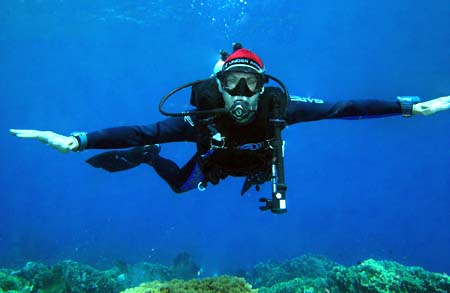
In fresh water, where all of my previous dives had taken place (with the exception of that saltwater pool, but that doesn't count), buoyancy is a constant struggle. It is quite hard to consistently stay off the bottom so as not to stir up silt. In seawater, if you have your weights right, that is simply not an issue. I just floated, glided, hovered, flew, without any problem at all. It felt like magic. And it's a good thing, too, because the plantlife on the reefs is far more fragile than I imagined and I sure did not want to harm it.
Diving a reef, I found, is like slowly flying over and through a Pixar landscape. It's like being in "A Bug's Life" or "Finding Nemo," only much more intense and, of course, real. Those guys at Pixar must be divers, I am sure. The diversity and vitality of all those plants is simply amazing: all sorts of sponges and gorgonians (seafans) are everywhere. Some cover rocks, some bulge out, some stick out weightlessly. There's a myriad of different kinds of coral. Fish dart in and out between them in a never-ending fluid dance. Some are lightning quick, some deliberate. The water is a very different medium to live and move around in.
After lunch I experienced my first ocean boat dive. We were on the green boat, the CoCo III. The boats are larger than the ones I'd been on on the Manatee snorkel tours, and the cutout in the center through with you can get back into the boat by climbing up a ladder is fairly unique. Divers sit along the sides by their gear.
The first actual dive site we visited was called "Too Tall Too Small." I am not sure where it got that name. My guess is the resorts get quite creative naming those sites as there are so many. It was a marvelous wall dive, again full of teeming life of all sorts. As I was gliding through this wonder world I thought of the Beatles song "Lucy in the Sky with Diamonds" where they sing of "cellophane flowers of yellow and green," and "newspaper taxis waiting to take you away" and similar. Some said that song was really about acid trips (Lucy in the Sky with Diamonds), but though I have no firsthand experience I cannot imagine an acid or any other drug-induced trip to be any wilder than diving a reef.
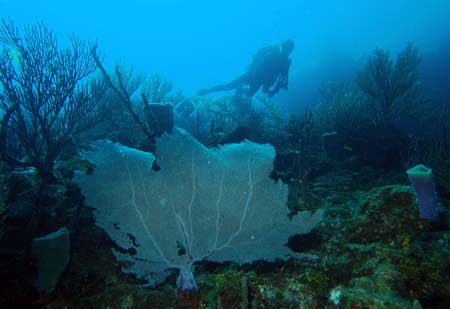
The combination of weightlessly floating amidst this unreal, unbelievable underwater world with colors and shapes I'd never seen; hearing myself breathing air from a tank on my back; knowing that I was deep under the surface and really in quite a fragile position, it all adds up to a suspense of reality as we know it on the surface. It makes you think and question things. There's so much down there, and it's all so different from the familiar dry world above. The ocean is huge and endless but also delicate and tender. A single boat anchor carelessly dragged across the reefs can destroy what took decades or hundreds of years to build, and what is home to an intricate miraculous world that is a miracle.
Posted by conradb212 at 11:50 PM
August 23, 2008
Dive trip to Honduras!
I am finally on my first real dive trip! It's taken me over two years to graduate from those initial checkout dives in Folsom Lake to my first diving experience in the ocean. That's ridiculously long, especially considering that I've been running a full dive website for more than two years, and that I've written this book about diving. But now I am on Roatan Island off Honduras, and tomorrow morning I'll have my first ever ocean dive.
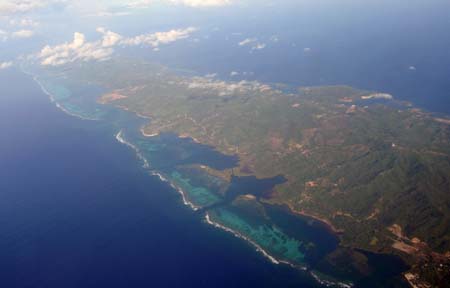
We're at CoCo View Resort on the southside of Roatan. CoCo View is not a resort in the traditional luxury accommodations sense of the word. It's a community of bungalows, cabanas and buildings on a totally secluded penninsula. It's tropical to the max, with flocks of Hummingbirds darting around, palm trees and other lush tropical greenery everywhere. Some of the bungalows and cabanas are directly on the water. Yes, I can actually see the water between the cracks of the floorboards in my room.
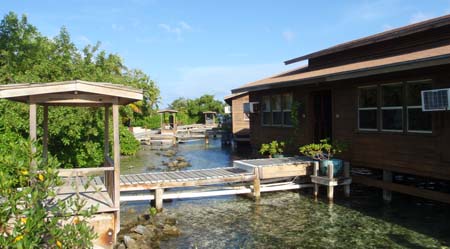
Getting to Roatan is easy. It may be a penninsula off an island off mainland Honduras, but all it took was a three and a half hour Continental flight from Sacramento to Houston, and then another two and a half hour flight from Houston to Roatan island. And not in a tiny turboprop, but in a real Boeing 737. Flying along the central American coast line is an experience by itself. There is so much pristine, gorgeous and seemingly uninhabited beach with inlets and islands. Is it yet to be discovered? Is it protected? What's the deal?
Immigration at Roatan airport is a lengthy procedure with stern customs officers handwriting and hand-copying lots of stuff. I am sure it serves a purpose, but hey.... we're just here for a week of spending money and boosting the local economy. It's hot and incredibly humid waiting in line. Our luggage has bright pink CoCo View tags and is being picked up and moved through customs by friendly folks from the resort. We're being greeted and soon sit in a nicely air-conditioned Kia van.
The ride from the airport to CoCo View is maybe 20 minutes and what I see is, on a somewhat less extreme scale, what I remember from a late 1970s trip to El Salvador. Visible from the streets is a weird mix of wealth and poverty, American-style shopping strips and much more modest local stores, corrugated steel covered huts and driveways to mansion and resorts.
The ride ends at a large boathouse from where we're ferried to the actual resort, just a few stone's throws away across a still lagoon, and yet so far from civilization. We get a brief intro from a friendly young American woman who hands out forms and the usual disclaimers. There are two young couples from New Jersey and some guys. How many dives do I have? That'd be 36. How many night dives? Ummm... one. Dive buddy Carol senses my intimidation and volunteers that my one night dive was the mother of all night dives. I remember well. It was. But I am still sure that everyone else is vastly more experienced, and they are a bunch younger, too.
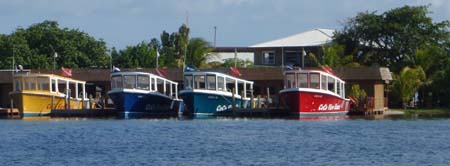
I pick up the key to the cabana on the water and it is sensational, just gorgeous. Hot and humid despite the big room air conditioner, but that's to be expected. I am blown away. Pretty much everyone who comes here is a diver and so instructions on what to do are in the room. We unpack and gather up our gear and walk on over to the dive building and dock. Four boats are there, painted yellow, red, green, blue. We've been assigned to the green boat, CoCo III. They are sturdy vessels that, as I later learn, even have an opening in the center for divers to climb in.
We store our gear in cubbies, then sign in to get weights. They are the old-fashioned solid lead weights. The two couples are here and they seem to know exactly how much weight they need. Me, I tried in the pool and sort of figured I might need 14 pounds. So that is what I get.
I am not sure I want to use Nitrox as it costs $8 a fill or $120 for the week whereas air is included. Carol uses it, and so I make my first three tanks Nitrox as well. We test for oxygen content and pressure, note the data on a sticker on the tank, then deposit our passports at the office. At the signup sheet I see that the Jersey couples have already signed up for the shark dive.
What have I gotten myself into? Will this work out? It's gorgeous here for sure, but what awaits me beneath the surface?
Posted by conradb212 at 7:46 PM
August 11, 2008
Dogs, tanks, suits and Nitrox
Sometimes you go diving and it's just for fun. Other times you learn a bunch of new things as I found out this past weekend at Lake Tahoe. 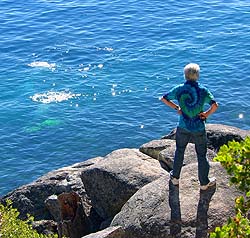 Instead of Meeks Bay which is usually overrun with certification classes, we went back to the D. L. Bliss State Park just a few miles away from Meeks. That's the site of the (in)famous Rubicon Wall that plunges down from 60 feet or so to a depth of 1,500 feet within just a quarter mile. Unfortunately, the trail from the Callawee Cove parking lot is a plunge all by itself, and quite a pain with scuba gear on. Still, the lure of the secluded beach and the wall were enough to make us go back.
Instead of Meeks Bay which is usually overrun with certification classes, we went back to the D. L. Bliss State Park just a few miles away from Meeks. That's the site of the (in)famous Rubicon Wall that plunges down from 60 feet or so to a depth of 1,500 feet within just a quarter mile. Unfortunately, the trail from the Callawee Cove parking lot is a plunge all by itself, and quite a pain with scuba gear on. Still, the lure of the secluded beach and the wall were enough to make us go back.
Parking at D.L. Bliss is just six bucks a day, a real bargain when you consider the giant size of the park (it takes a mile on a narrow, winding forest road to even get to the park entrance gate) and the gorgeous vistas. It's a bit like Big Sur with lots of woods and nature. We arrived at the smallish Callawee Cove lot at 9:30AM when you can still pick your spot. As always with diving, the closer to the beach you can get the better.
This time, with the memory of lugging those giant 104-cubic foot steel tanks down (and up!) the steep trail, we brought comparatively tiny high pressure steel-80s. They don't look very manly, those tanks, but on this trip I certainly got to appreciate them. Sure, I only had 80 cubic-foot of air instead of 104, but that was enough, and the big difference in size and weight made this trip about diving and not about scaling what seems like 700 steps up a vertical cliff.
![]()
I never really realized before how important picking the right tank is. As much as I had read about tanks, when I bought my own first tanks I got my two used low-pressure steel-95s because Robert at Diver's Cove in Folsom recommended them, and my metallic-blue anodized aluminum 80 because it looked great. The steel 95s are good but I don't think I ever got a full 2,400 psi charge, and when you begin with 2,100 psi or so, there just isn't all that much air in them. The blue alu tank does look great, but it's actually even longer than the steel-95s, so it's quite a handful for just 80 cubic feet of air, and that's before the annoying buoyancy issues of aluminum tanks (I'll get into that!). So I think I'll relegate the pretty blue tank to pool duty, sell the steel 95s, and invest in high pressure steel 100s if we can find them at a reasonable price. High pressure tanks have their own issues (filling time, availability of high pressure fills, etc.) but at this point weight and length of a tank have become important to me. If you routinely have to carry tanks by the valve, having one that you can carry without it dragging the ground makes things so much easier.
But it's not only tanks where there is no substitute for practical experience. The same goes for wetsuits. While I liked the first wetsuit I ever bought, a 7mm Telos, the thing was so difficult to get into that I started all my dives already exhausted. And pulling the recalcitrant material up your arms and legs practically guarantees sore fingertips as the side of the nails dig into the soft parts. The answer there is to get a suit that really fits. My Telos, for example, was a "medium," which meant it fit my 6-foot, 155 pound frame snugly, but arms and legs were too short. No fun.
Well, Carol pointed out that some wetsuits come in "medium-long," though dive shops don't usually carry the size. My new 7mm Scubapro "Form" wetsuit does come in that size and it fits great. It's also made from a material that is super-stretchy and therefore goes on a whole lot easier. Nothing is ever perfect, though. Somehow it must have escaped Scubapro that Velcro grabs this material like crazy. When you pull the velcro off, it rips the surface layer of the wetsuit material. Scuba gear uses lots of velcro, and so it won't be long before suits made of this material look all chewed up. Anyway, I love the suit and we'll see how it holds up.
The water temperature at Tahoe was 68 degrees as it usually is in the summer. However, I knew from prior dives that it gets colder quickly as you go down and so I used my hood and gloves. I had some concerns about the gloves as we took a test camera along, the new DC800 from SeaLife. The folks at SeaLife have this amazing ability to retrofit ordinary digital camera equipment for underwater duty by tweaking the software and adding special underwater modes that go well beyond what consumer cameras with an underwater setting or two offer. A lot of their magic comes from special white balance modes that correct for the way water filters out different colors as you go deeper. They also know that divers do wear gloves on occasion, and so the buttons on their underwater housings are always spaced to accommodate gloves. It may have escaped them, however, that older divers need reading glasses to see fine print and tiny icons, and so that can be an issue.
I had used Nitrox at the quarry in Tennessee, but this was the first time at altitude. I had contemplated the impacts of altitude on diving before, taken the PADI altitude diver class (twice, really), and read up on the subject. It's hard enough to wrap your mind around the logic of altitude diving on air (it's the ratio of the pressure differences between surface and a certain depth underwater that determines nitrogen absorption, and not the absolute pressure!), and it's worse for Nitrox where you essentially have to determine equivalent air depths twice. From talking to various people and also reading bulletin board posts on the matter, it seems that very few really know how it works. It makes no difference, of course, as everyone relies on their dive computer.
![]() It's interesting to see just how much dive tables and dive computers differ when it comes to the real world. NAUI, for example, sells tables for diving at altitude with 32 and 36% Nitrox as well as for air dives. There are two sets of tables, one for altitudes between 6,000 and 10,000 feet and one for 1,000 to 6,000 feet. My dive eventually took me to 64 feet. Rounded up to 70 feet, the NAUI sea level tables would allow for a maximum dive time (MDT) of 45 minutes. The altitude air table cuts that to 21 minutes. That's because diving 64 feet at 10,000 feet of altitude is more like diving 100 feet or so at sea level as far as nitrogen uptake goes. This is where Nitrox comes in handy. Its lesser percentage of nitrogen increases maximum dive time from 21 to 32 minutes with 32% Nitrox, and 37 minutes with 36% Nitrox. So when diving at altitude, using Nitrox increases maximum bottom times when compared to air, just as it does at sea level.
It's interesting to see just how much dive tables and dive computers differ when it comes to the real world. NAUI, for example, sells tables for diving at altitude with 32 and 36% Nitrox as well as for air dives. There are two sets of tables, one for altitudes between 6,000 and 10,000 feet and one for 1,000 to 6,000 feet. My dive eventually took me to 64 feet. Rounded up to 70 feet, the NAUI sea level tables would allow for a maximum dive time (MDT) of 45 minutes. The altitude air table cuts that to 21 minutes. That's because diving 64 feet at 10,000 feet of altitude is more like diving 100 feet or so at sea level as far as nitrogen uptake goes. This is where Nitrox comes in handy. Its lesser percentage of nitrogen increases maximum dive time from 21 to 32 minutes with 32% Nitrox, and 37 minutes with 36% Nitrox. So when diving at altitude, using Nitrox increases maximum bottom times when compared to air, just as it does at sea level.
Now how does all that theory translate into what the dive computer shows during an actual dive? Well, at no time did my no-decompression time fall below 60 minutes. And once set to 36% Nitrox, my Uwatec SmartZ also correctly showed an altitude-adjusted maximum oxygen depth of 100 feet. That's about six feet more than at sea level. Most people would expect less, but as far as oxygen goes, absolute pressure matters and so you reach the recommended 1.4 atmosphere partial pressure of oxygen a few feet deeper at Tahoe altitudes.
It's definitely a good thing to plan one's altitude dives, but once you're down there, the dive computer takes over. And at least in my case, maximum allowable dive time was a lot longer than my air would have lasted. I am getting better with my air consumption, but I am still sucking it up at an alarming rate when I get tense, and diving that wall at Rubicon point is still a somewhat scary experience for me.
The beach at Callawee Cove is shallow. You can dive along the rock cliffs and never reach more than 15-18 feet or so. However, swim away from the beach at the point, and there's the wall. Part of it is just a sheer wall, stark and forbidding. Other parts are giant boulders. All in all, it goes from 60 feet or so down to a 1,500 foot abyss within just a quarter mile. Visibility was far less than when we dove the wall last year. We had at least a hundred feet then, but this time it was just 50 or so, as we had already noticed during other Tahoe dives this year. I am not sure why that is; it must be some sort of local phenomenon as I cannot imagine clarity going down by that much within a single year. Tahoe is totally clean and clear, and pollution simply cannot be a sizable problem. Maybe it was ash and dust from all the California wildfires, and that may also account for the lower water temperatures.
Anyway, I never like low visibility, and its worse when there are severe thermoclines. This time we hit two, each gripping one's entire body. ![]() At 65 feet it was already down to 50 degrees. I wasn't uncomfortably cold with the hood and gloves, but between the relatively low visibility, the cold, and the menacing face of the wall, I was breathing hard. By now I know that I do not fall when I cannot see the bottom, but it is still a weird feeling. I did not want for it to overcome me, and so when I saw the wall slowly came into view, I swallowed hard and decided to swim along the sheer and near vertical face of the wall. Last time I had gone over it from the top, following Carol. This time, Carol had gone up to the top and peeked over it, feeling "like the Lion King" as she later told me. I swam along the face, breathing hard and hoping I'd soon come to something other than the sheer face. During those two or three minutes it instantly became clear to me why "blue holes" that often have walls that recede as you go down are considered so dangerous. It's easy to freak when there is nothing below you and rock above. Also, at just 65 feet I didn't feel what I suppose was the calming (to me) influence of a bit of narcosis that I probably had felt at 110 feet. In any case, I am very glad I went back to Rubicon Wall. I love those rock faces and giant boulders, but I'd like them that much better in clearer, warmer water.
At 65 feet it was already down to 50 degrees. I wasn't uncomfortably cold with the hood and gloves, but between the relatively low visibility, the cold, and the menacing face of the wall, I was breathing hard. By now I know that I do not fall when I cannot see the bottom, but it is still a weird feeling. I did not want for it to overcome me, and so when I saw the wall slowly came into view, I swallowed hard and decided to swim along the sheer and near vertical face of the wall. Last time I had gone over it from the top, following Carol. This time, Carol had gone up to the top and peeked over it, feeling "like the Lion King" as she later told me. I swam along the face, breathing hard and hoping I'd soon come to something other than the sheer face. During those two or three minutes it instantly became clear to me why "blue holes" that often have walls that recede as you go down are considered so dangerous. It's easy to freak when there is nothing below you and rock above. Also, at just 65 feet I didn't feel what I suppose was the calming (to me) influence of a bit of narcosis that I probably had felt at 110 feet. In any case, I am very glad I went back to Rubicon Wall. I love those rock faces and giant boulders, but I'd like them that much better in clearer, warmer water.
Nitrox worked well for me, but then again I'd never had a problem with just air. So for now I know that Nitrox doesn't make me feel weird or anything. There's psychology in that. You need to find out for yourself how something makes you feel.
After a two-hour surface interval on the beautiful beach of the cove we did a second dive. This one was just for fun, poking around the rocks and boulders along the shallow shore. It rarely got to be more than 15 feet deep. We took movies with the SeaLife (once in its case, you cannot switch between still pictures and movies, so you need to decide what mode to use beforehand), watched whole colonies of feisty crawdads do their thing, marveled at how warm the fine sand at the bottom was when you stick your hands in it, and just played around.
![]() This second dive was also a lecture in what an impact different types of tanks can have, and how even the same tank can behave differently when it gets empty. On the first dive I had used the high-pressure steel-80 tank and used 16 pounds of weight in the two pockets of my Scubapro Knighthawk BC. For the second dive I switched to my electric-blue Aluminum-80 tank, this time using 18 pounds to make up for the aluminum tank's higher buoyancy. Carol, who generally barely uses any weights at all, had on her new 7mm wetsuit and was on her second dive with the same tank. She doesn't like a lot of weight and dropped two pounds for this dive. As a result of the different buoyancy she now had trouble going down with eight pounds instead of the ten she'd used on the first dive, and so we switched things around again. Having less weight came back to haunt me after I'd used up about 900 psi of air. As we were returning to the beach and I found myself increasingly unable to stay at the shallow depths as my aluminum bottle was getting more and more buoyant, until I signaled it was no use and I had to surface, and so I did. Note to self: tanks that switch from negative to positive buoyancy are a pain.
This second dive was also a lecture in what an impact different types of tanks can have, and how even the same tank can behave differently when it gets empty. On the first dive I had used the high-pressure steel-80 tank and used 16 pounds of weight in the two pockets of my Scubapro Knighthawk BC. For the second dive I switched to my electric-blue Aluminum-80 tank, this time using 18 pounds to make up for the aluminum tank's higher buoyancy. Carol, who generally barely uses any weights at all, had on her new 7mm wetsuit and was on her second dive with the same tank. She doesn't like a lot of weight and dropped two pounds for this dive. As a result of the different buoyancy she now had trouble going down with eight pounds instead of the ten she'd used on the first dive, and so we switched things around again. Having less weight came back to haunt me after I'd used up about 900 psi of air. As we were returning to the beach and I found myself increasingly unable to stay at the shallow depths as my aluminum bottle was getting more and more buoyant, until I signaled it was no use and I had to surface, and so I did. Note to self: tanks that switch from negative to positive buoyancy are a pain.
I listed dogs in the title of this entry. Where do they come in? Well, we had fun watching some Retrievers and Labs play in the water during our dives. But that wasn't why I mentioned it. Like everyone else, I had learned to look up before surfacing so as not to collide with a boat. I did that and none were in sight. But when I came up I bumped into .... a dog. It was a chocolate Lab, and he'd probably been investigating my bubbles. He was just as surprised as I was and quickly doggie-paddled off. Me, I couldn't stop laughing.
Posted by conradb212 at 4:07 PM








